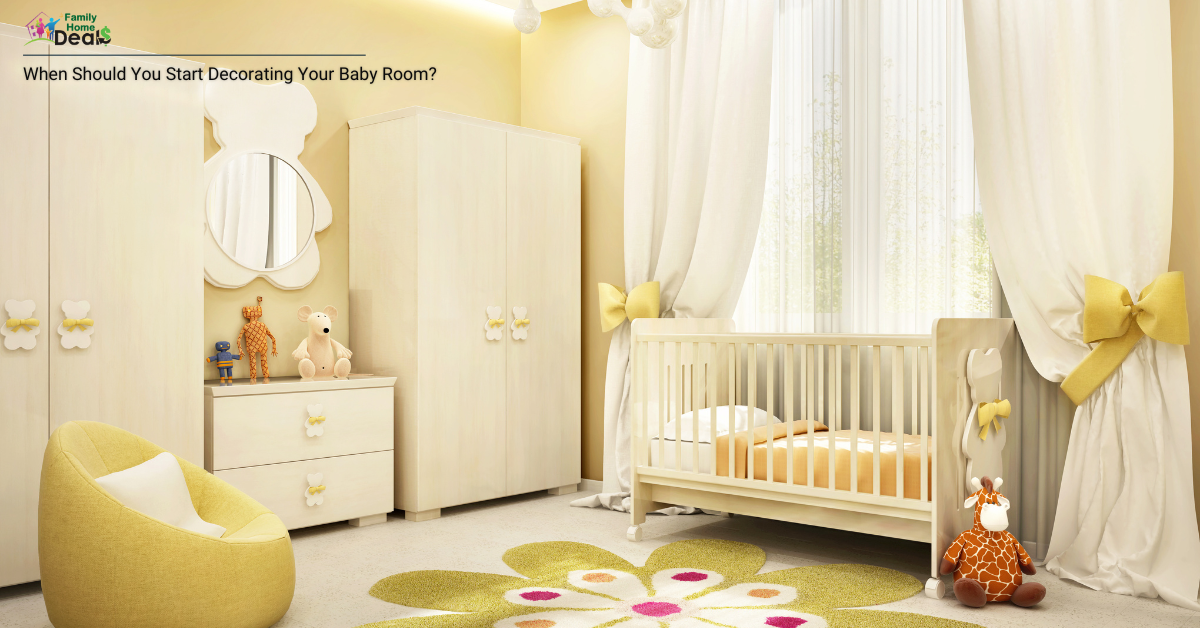
Bringing a new baby into your life is one of the most exciting experiences, and decorating the nursery is a significant part of the journey. This space will be where your baby sleeps, plays, and grows, so it’s essential to make it a cozy, safe, and nurturing environment. But when is the right time to start decorating? And what colors should you choose to create the perfect atmosphere? These questions often weigh on the minds of expectant parents, but don’t worry—we’ve got you covered.
This guide will walk you through everything you need to know about decorating a babys room, from choosing the best colors to determining the ideal time to get started. We’ll offer practical advice, expert tips, and a few creative ideas to help you create a beautiful, functional space where your baby will thrive. So, whether you’re already expecting or just planning ahead, read on to find out how to make your baby’s room the best it can be.
When Should You Start Decorating Your Baby Room?
The Ideal Timeline
Timing is crucial when it comes to decorating a baby’s room. You want to ensure everything is ready before your little one arrives, but you also don’t want to start too early or too late. Typically, the best time to start decorating is during the second trimester, around the 20-week mark. By this time, you’re likely past the initial pregnancy fatigue and morning sickness, and you have plenty of energy and excitement to tackle the nursery project.
Starting in the second trimester also gives you ample time to plan, shop, and make decisions without feeling rushed. You’ll want to leave enough time for any furniture deliveries, painting, or assembly, which can sometimes take longer than expected. Plus, starting early allows you to enjoy the process without the stress of a looming due date.
Things to Consider Before Starting
Before you dive into decorating, there are a few key considerations to keep in mind:
- Gender Reveal: If you plan to find out the baby’s gender, you might want to wait until after the reveal to start decorating. This can influence your color and theme choices.
- Space Planning: Take measurements of the room and create a rough layout. Decide where the crib, changing table, and other essential furniture pieces will go.
- Budget: Establish a budget early on to avoid overspending. Prioritize items that are necessary for the baby’s safety and comfort.
- Health Precautions: Remember that pregnant women should avoid exposure to toxic fumes from paint or new furniture. Choose low-VOC (volatile organic compound) paints and allow plenty of time for the room to air out.
How to Decorate a Baby’s Room: Step-by-Step Guide
1. Choose a Theme or Style
The first step in decorating your baby’s room is deciding on a theme or style. Whether you’re drawn to classic, modern, rustic, or whimsical designs, having a theme helps create a cohesive look. Some popular themes include:
- Animal Safari: Think elephants, lions, and giraffes, with earthy tones and natural textures.
- Under the Sea: Blue hues, aquatic creatures, and ocean waves create a soothing, watery world.
- Space Adventure: Stars, planets, and rocket ships inspire curiosity and wonder.
- Fairy Tale Forest: Enchanted trees, woodland creatures, and soft, pastel colors evoke a magical atmosphere.
If you’re not into themes, you can opt for a more general style like minimalist, Scandinavian, or vintage. Whatever you choose, make sure it aligns with your personal taste and feels comfortable, as you’ll be spending a lot of time in this room.
2. Pick the Right Colors
Color is one of the most crucial elements in decorating a baby’s room. The right color scheme can set the mood, influence the baby’s emotions, and even promote better sleep. Here are some tips for choosing the best colors:
- Soft Neutrals: Light grays, creams, and beiges create a calm, serene environment that is easy on the eyes and won’t overstimulate your baby. Neutrals also provide a versatile backdrop that can be easily updated as your child grows.
- Pastels: Gentle shades of pink, blue, green, and yellow are classic choices for nurseries. They are cheerful without being overwhelming, and they pair well with a variety of themes and décor styles.
- Muted Hues: If you prefer a bit more color, consider muted versions of bolder shades like dusty rose, sage green, or slate blue. These colors add personality without overpowering the space.
- Monochromatic Schemes: For a modern look, choose one color and use different shades and tones throughout the room. This approach creates a sophisticated, cohesive design that is visually pleasing.
3. Select Safe and Functional Furniture
When decorating a baby’s room, safety and functionality should be top priorities. Here’s what you need to consider:
- Crib: The crib is the centerpiece of the nursery. Ensure it meets all current safety standards, with slats no more than 2.375 inches apart. Choose a firm mattress and avoid adding extra pillows, blankets, or bumpers.
- Changing Table: Opt for a changing table with plenty of storage space for diapers, wipes, and baby clothes. Some parents prefer a dresser with a removable changing pad on top for added versatility.
- Rocking Chair or Glider: A comfortable chair is essential for those late-night feedings. Look for one with good back support and soft cushions.
- Storage Solutions: Babies come with a lot of stuff! Invest in baskets, bins, shelves, and drawers to keep everything organized and within reach.
4. Add Personal Touches
Personalizing your baby’s room makes it special and unique. Here are a few ideas to add those finishing touches:
- Wall Art: Hang framed prints, posters, or canvases that reflect your theme or color scheme. You could also include personalized artwork, like your baby’s name or birth date.
- Rugs and Curtains: Choose a soft, plush rug that adds warmth and comfort to the room. Curtains should be light-blocking to ensure a dark, sleep-friendly environment.
- Bedding and Textiles: Stick to simple, breathable bedding. Decorative pillows and blankets can add color and texture but should be removed from the crib during sleep.
- Lighting: Soft, adjustable lighting is crucial in a nursery. Consider a dimmable lamp or nightlight for those middle-of-the-night feedings.
- Toys and Books: Display a selection of toys and books that you’ll use with your baby. Shelving or baskets work well for this purpose, keeping everything tidy and accessible.
What Are the Best Colors for a Baby Room?
Understanding Color Psychology
Colors can have a significant impact on mood and behavior, even for babies. Understanding the psychology behind colors can help you create a nursery that is not only beautiful but also beneficial for your baby’s development. Here are some commonly used colors and their effects:
- Blue: Often associated with calmness and tranquility, blue is an excellent choice for promoting sleep. It can lower blood pressure and heart rate, making it perfect for a nursery. However, avoid dark shades that may feel too cold or somber.
- Yellow: Yellow is a cheerful, uplifting color that stimulates mental activity. It’s great for creating a sunny, happy atmosphere, but be cautious—too much bright yellow can be overstimulating and may lead to irritability.
- Green: Green is the color of nature and is believed to have a calming effect. It’s associated with health, healing, and tranquility, making it a popular choice for nurseries. Light, soft greens are especially soothing.
- Pink: Traditionally associated with femininity, pink is a warm, comforting color that can evoke feelings of love and care. It’s a popular choice for baby girls’ rooms but can work well in any nursery.
- Purple: Purple is often associated with luxury, creativity, and calmness. Lighter shades like lavender are soothing, while deeper shades like plum can add a touch of sophistication.
- White: White symbolizes purity and innocence. It creates a clean, fresh environment and can make a small room feel more spacious. However, too much white can feel sterile, so consider adding pops of color through accessories.
Combining Colors
You don’t have to stick to just one color. Combining two or more colors can create a balanced and visually appealing nursery. Here are some ideas:
- Blue and White: A classic combination that’s fresh and calming. Use blue on the walls and white for furniture and accessories.
- Gray and Yellow: This modern combo is gender-neutral and can be easily adapted as your child grows.
- Pink and Gray: A soft, elegant pairing that works well for a baby girl’s room.
- Green and Beige: Earthy and natural, this combination brings the outdoors in, creating a serene environment.
Final Tips for Decorating Your Babys Room
1. Keep It Simple
It’s easy to get carried away with all the adorable nursery décor options, but sometimes less is more. A clutter-free, simple design is not only easier to maintain but also more soothing for your baby.
2. Plan for the Future
While your baby won’t stay little forever, it’s a good idea to choose décor that can grow with them. Opt for timeless furniture and colors that can be easily updated as your child’s tastes evolve.
3. Safety First
Always prioritize safety when decorating a baby’s room. Anchor heavy furniture to the walls, cover electrical outlets, and keep small objects out of reach.
4. Involve Loved Ones
Decorating a nursery can be a wonderful way to involve family and friends in the excitement of your baby’s arrival. Consider hosting a “nursery decorating party” where loved ones can help with painting, assembling furniture, or adding personal touches.
Conclusion
Decorating your baby’s room is an exciting and fulfilling project that allows you to create a special space for your new arrival. By starting around the 20-week mark of your pregnancy, choosing a soothing color palette, and incorporating personal touches, you can design a nursery that is both beautiful and functional. Whether you opt for a themed room or a simple, minimalist design, the key is to make it a place where you and your baby feel comfortable and happy.
Remember, there’s no one-size-fits-all approach to decorating a nursery. Trust your instincts, and don’t be afraid to get creative. After all, this is your baby’s first room, and it should be as unique and special as the little one who will soon call it home. With thoughtful planning and a bit of love, you can create a nursery that not only looks great but also fosters a nurturing, peaceful environment for your baby to grow and thrive.


